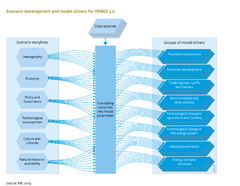Drivers/Scenario drivers: Difference between revisions
< Drivers
Jump to navigation
Jump to search
No edit summary |
No edit summary |
||
| Line 14: | Line 14: | ||
The future state of the world depends on the population because total demand for goods and services equals the number of people times demand per capita. | The future state of the world depends on the population because total demand for goods and services equals the number of people times demand per capita. | ||
Most population projections used as input to the IMAGE model have been adopted from published sources, such as data from the United Nations ([[UN, 2013]]) and projections by the International Institute for Applied Systems Analysis ( | Most population projections used as input to the IMAGE model have been adopted from published sources, such as data from the United Nations ([[UN, 2013]]) and projections by the International Institute for Applied Systems Analysis ([[IIASA]]) ([[Lutz and KC, 2010]]). Behind these numerical projections are economic, technical, educational and policy assumptions that determine the estimated future population as the net outcome of fertility and mortality, adjusted for migration flows. This has provided internally consistent, overall population scenarios on the basis of underlying demographic trends. | ||
In addition to total number of people, the population is broken down into gender, income classes, urban and rural, and educational level. These attributes are relevant for issues such as consumption preferences and patterns, and access to goods and services. Using a downscaling procedure ([[Van Vuuren et al., 2007b]]), national and regional population can be projected at grid level to account for trends in urbanisation and migration within countries and regions. | In addition to total number of people, the population is broken down into gender, income classes, urban and rural, and educational level. These attributes are relevant for issues such as consumption preferences and patterns, and access to goods and services. Using a downscaling procedure ([[Van Vuuren et al., 2007b]]), national and regional population can be projected at grid level to account for trends in urbanisation and migration within countries and regions. | ||
Population data are used in energy and agricultural economics modelling, and in other IMAGE modules, such as [[Water|water stress]], [[ | Population data are used in energy and agricultural economics modelling, and in other IMAGE modules, such as [[Water|water stress]], [[Nutrient balances|nutrients]], [[Flood risks|flood risks]] and [[Human development|human health]]. | ||
Revision as of 12:17, 9 May 2014
Parts of Drivers/Scenario drivers
| Projects/Applications |
| Models/Databases |
| Relevant overviews |
| Key publications |
| References |
